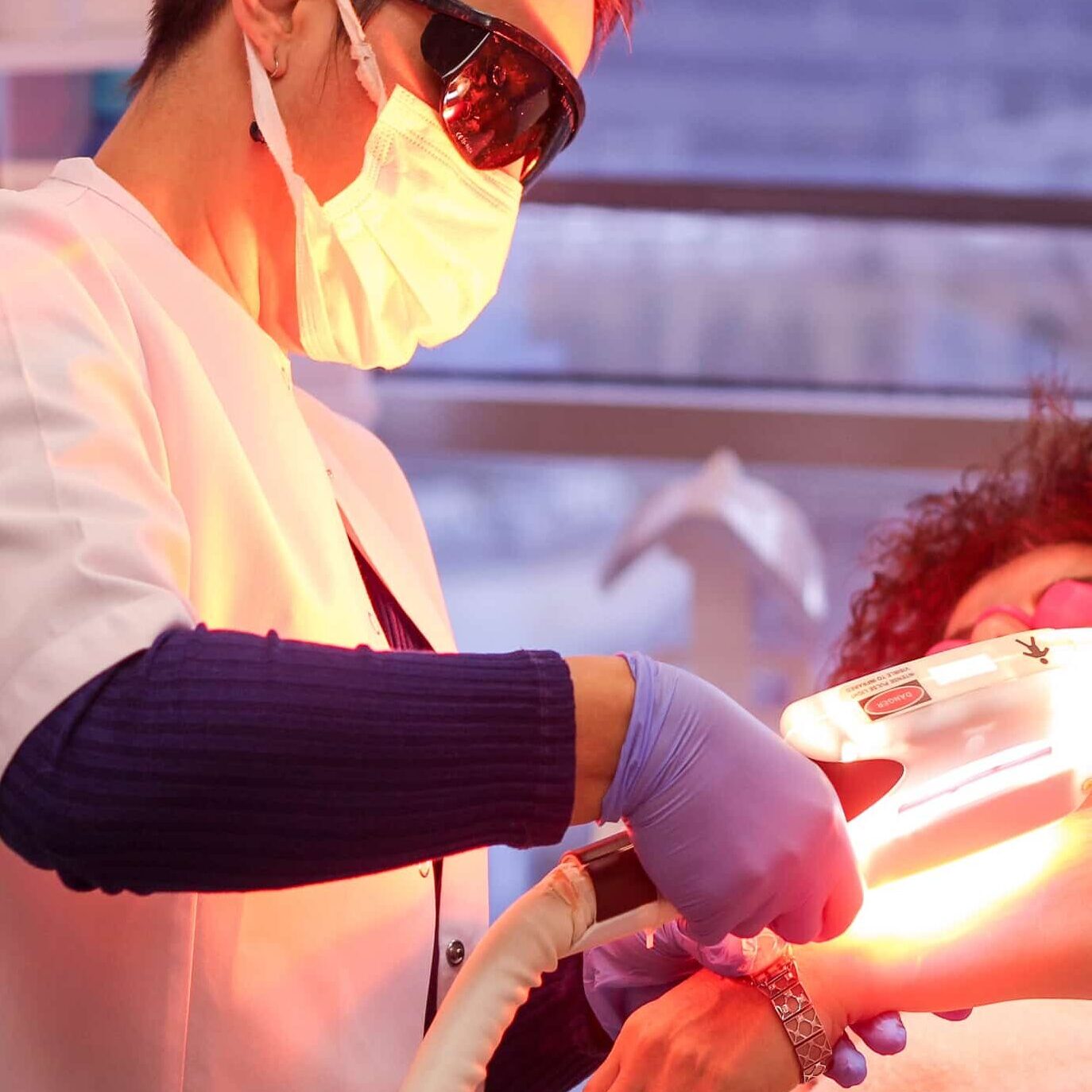As summer approaches and the desire for smooth, hair-free skin intensifies (although hair removal treatments are beneficial year-round), many individuals are drawn to the idea of laser hair removal. It’s a personal preference, as everyone has different principles and preferences when it comes to their bodies. For those seeking a long-lasting solution, laser removal treatments offer the potential for permanently reduced hair growth, leaving the skin feeling smooth.
Today, we will explore various laser hair removal tips and tricks, along with a helpful guide on how to prepare for your sessions. By following these guidelines, you can maximize the effectiveness of your treatments and ensure a smooth and successful experience. Let’s dive right in!


What is Laser Hair Removal?
Laser hair removal is a popular cosmetic procedure that uses concentrated beams of light to remove unwanted body hair. It is a safe and effective method of achieving long-term hair reduction. The laser emits a specific wavelength of light that is absorbed by the pigment in the hair follicles.
This light energy is converted into heat, damaging the follicles and inhibiting future hair growth.
What are Laser Hair Removal Benefits?
A brief introduction to laser hair removal benefits,
Laser hair removal has gained significant popularity in recent years due to its numerous benefits and effectiveness in reducing unwanted hair. Here is s brief introduction to laser hair removal benefits and some factors contributing to its popularity:
1. Long-term Hair Reduction: Unlike temporary hair removal methods such as shaving or waxing, laser hair removal offers long-lasting results. It targets the hair follicles, inhibiting future hair growth and providing a more extended period of smooth skin.
2. Convenience and Time-saving: Laser hair removal eliminates the need for regular and time-consuming hair removal routines. With fewer sessions required over time, individuals can enjoy the convenience of reduced maintenance and save valuable time.
3. Precision and Targeting: Laser technology allows for precise targeting of specific areas, ensuring that only the unwanted hair is treated while leaving the surrounding skin unharmed. This precision is especially beneficial for sensitive areas like the face or bikini line.
4. Reduced Ingrown Hairs: Ingrown hairs can be a common problem with other hair removal methods. Laser hair removal helps minimize the occurrence of ingrown hairs, resulting in smoother and healthier-looking skin.
5. Advancements in Technology and Safety: Over time, laser hair removal technology has advanced, making the procedure safer, more effective, and suitable for a wider range of skin types and tones.
Professionals can adjust the laser settings to accommodate different skin and hair characteristics, ensuring optimal results with minimal risk.
6. Popularity among Both Genders: Laser hair removal is not limited to a specific gender. It has gained popularity among both men and women, as individuals from various backgrounds and lifestyles seek a long-term solution for hair reduction.
How Safe is Laser Hair Removal for Different Skin Types?
Laser hair removal is considered a safe cosmetic procedure when handled and performed by trained professionals using FDA-approved devices. The advanced technology and protocols ensure minimal risk and maximize safety for individuals undergoing the treatment.
However, it’s essential to consult with a qualified practitioner who will evaluate your skin type, hair color, and medical history to determine the suitability of the procedure for you.
By sticking to proper safety guidelines and following post-treatment care instructions, the risks associated with laser hair removal, such as temporary skin redness or mild discomfort, can be minimized.
With the increasing popularity and advancements in laser technology, the safety and efficacy of laser hair removal continue to improve, providing individuals with a reliable and safe solution for long-term hair reduction.
How Many Sessions for Laser Hair Removal?
The number of sessions required for laser hair removal varies depending on several factors, including the individual’s hair type, skin tone, and the targeted treatment area. On average, most people need around 6 to 8 sessions to achieve significant and long-lasting hair reduction.
It’s important to note that hair grows in cycles, and not all hair follicles are active at the same time.
Multiple sessions ensure that all hair follicles are treated during their active growth phase.
While laser hair removal provides long-lasting results, it is not considered a permanent solution. Some individuals may experience hair regrowth over time, which can be managed with maintenance sessions as needed.
Consistency is key for optimal outcomes, and completing the recommended number of sessions increases the chances of successful hair reduction.
Not undergoing multiple sessions of laser hair removal treatments can impact the effectiveness and long-term results of the procedure. Hair grows in cycles, and laser hair removal targets hair follicles during their active growth phase.
By completing only one session, you may experience temporary hair reduction, but there may be dormant hair follicles that were not treated. Without additional sessions, these untreated follicles may continue to grow hair over time.
Prepare for Laser Hair Removal Treatment
Preparing for laser hair removal treatment is an important step to ensure the best possible results. Before your session, it is advised to shave the treatment area a day or two prior to the appointment.
Avoid waxing, plucking, or using depilatory creams as they remove the hair follicles that the laser targets.
It’s also essential to protect your skin from sun exposure before and after the treatment, as tanned skin can be more sensitive to laser energy.
Additionally, it’s recommended to avoid applying any creams, lotions, or perfumes on the treatment area on the day of your appointment.
By following these simple laser hair preparation tips, you can help create the ideal conditions for a successful and comfortable treatment session.
Can I use Tanning Bed After Laser Hair Removal ?
Tanning bed after laser hair removal treatments should be avoided at all costs for a certain period of time.
The intense UV exposure from tanning beds can be harsh on the treated skin, which may still be sensitive after the procedure.
The skin needs time to heal and recover, so exposing it to UV rays can increase the risk of complications like hyperpigmentation or skin damage. It is best to consult with your laser hair removal provider for specific instructions on when it is safe to use a tanning bed after your treatments.
Can I Self Tan After Laser Hair Removal?
It is generally recommended to refrain from using self-tanning products for a specific duration after laser hair removal. Although self-tanning on its own is a safe and beautiful way to get a sun-kissed glow, the treated skin may still be sensitive because of the laser hair removal treatments, and applying self-tanners could potentially irritate or disrupt the healing process.
Can Laser Hair Removal Make My Tan Patchy?
After laser hair removal, there is a possibility that your tan may appear patchy. This is because the laser targets the pigment in the hair follicles, and if you have a tan, the laser may also affect the surrounding skin pigment. As a result, the treated area may appear lighter or darker compared to the rest of your skin.
Potential Laser Hair Removal Side Effects
While laser hair removal is generally a safe and effective procedure, it’s essential to be aware of potential side effects.
Here are the potential laser hair removal side effects, presented in bullet points for clarity:
- Temporary redness and slight swelling in the treated areas
- Mild discomfort during or after the session
- Skin sensitivity, itching, or temporary changes in skin pigmentation
- Rare instances of blistering, scarring, or changes in skin texture (for instance, skin tightening)
Remember that these side effects are generally rare and temporary. By choosing a reputable provider and following proper guidelines, the risk of experiencing significant complications can be minimized.
Applying Proper Skincare
Taking proper care of your skin after laser hair removal is essential to promote healing and minimize potential side effects. Here are some tips to follow:
1. Avoid sun exposure: Protect the treated areas from direct sunlight or tanning beds for at least a week after the session. Use sunscreen with a high SPF and wear protective clothing when going outside.
2. Keep the area clean: Gently cleanse the treated skin with a mild cleanser to keep it clean and prevent infection. Avoid harsh scrubs or exfoliants that may irritate the skin.
3. Moisturize regularly: Apply a gentle, fragrance-free moisturizer to keep the skin hydrated and soothe any redness or dryness. Choose a moisturizer recommended by your practitioner or one specifically formulated for post-laser care.
4. Avoid hot showers and baths: For the first 48 hours, avoid hot water on the treated areas as it can increase inflammation. Instead, opt for lukewarm water when showering.
5. Skip activities that cause excessive sweating: Avoid vigorous exercise, saunas, hot tubs, or activities that make you sweat excessively for a few days after treatment. Sweating can irritate the treated skin and increase the risk of infection.
6. Avoid picking or scratching: Resist the urge to scratch or pick at the treated areas, as this can lead to scarring or infection. Let the skin heal naturally.
7. Follow post-treatment instructions: Your practitioner will provide specific post-treatment instructions based on your individual needs. Follow them carefully to ensure optimal results and minimize any potential complications.
Can Laser Hair Removal Treatments cause Hyperpigmentation?
While laser hair removal is generally a safe procedure, there is a slight risk of developing hyperpigmentation as a side effect. Hyperpigmentation refers to the darkening of the skin in the treated area.
It can occur more commonly in individuals with deeper skin tones or those who have a history of skin sensitivity.
However, the risk can be minimized by ensuring that the laser settings are adjusted appropriately based on the individual’s skin type.
How Much is Laser Hair Removal Treatment?
Laser hair removal can be relatively expensive due to several factors. Firstly, the cost is influenced by the advanced technology and specialized equipment used in the procedure. Laser devices designed for hair removal are precise and expensive to acquire and maintain.
Additionally, the cost of laser hair removal is determined by the expertise and qualifications of the professionals performing the treatment.
Licensed and experienced practitioners may charge higher fees for their services.
Moreover, the number of sessions required for optimal results contributes to the overall cost. Each session adds to the total cost of the treatment.
Lastly, the cost of laser hair removal can vary depending on the location and reputation of the clinic or spa.
It’s important to consider the long-term benefits of laser hair removal when evaluating the cost.
While the initial investment may seem high, the potential for long-lasting hair reduction can ultimately save money compared to the ongoing expenses of temporary hair removal methods.



